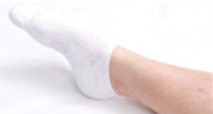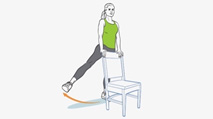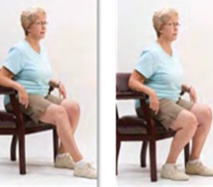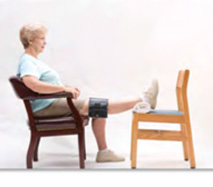Discharge Instructions:
What to expect after surgery?
It is normal to experience pain and swelling after surgery. At the end of the operation I use a long acting anesthesia to inject the soft tissues around the joint. This helps with pain control but will being to wear off. On day 2-3 after surgery it is not uncommon to feel more discomfort. The goal after surgery is to stay ahead of the pain curve and control our pain and swelling with medication and ice therapy.
Medications after surgery:
- Tylenol Extra Strength 1000mg every 8 hours by mouth (#120 pills, 1 refill)
- This is over the counter and is your first line medication for pain control. This should be taken around the clock every 8 hours for at least the first 2 weeks to help with pain control. Do not exceed more than 3000mg of Tylenol in a 24 hour period.
- Celebrex 100mg twice a day by mouth (#60 pills, 1 refill)
- This should be taken as well in combination with Tylenol for pain control for 4 weeks. Celebrex is a prescribed strong anti-inflammatory that will help with pain. If pain is not controlled you may double the dosage to 2 pills, 200mg twice per day. The maximum daily dosage is 400mg in a 24-hour period.
- Tramadol 50mg every 6 hours by mouth as needed for pain (#30 pills)
- This is your second line pain medication and should be taken as needed for moderate to severe pain. If needed you may increase the dosage to 100mg every 4-6 hours for added pain control. Maximum dosage in 24 hours is 400mg.
- Oxycodone 5mg every 4-6 hours by mouth as needed for pain (#30 pills)
- This is prescribed for severe breakthrough pain. You can take 1 tablet for moderate pain or 2 tablets for severe pain every 6 hours as needed. Do not take more than 8 tablets in a 24hour period.
- Aspirin 81mg twice daily by mouth for 6 weeks (#84 pills)
- This is to prevent blood clots. Start taking aspirin in the evening after surgery.
- Colace 100mg twice daily by mouth daily as needed for constipation (#28 pills)
- This is an over the counter medication and will help to prevent constipation.
- *Any allergy or intolerance to one of the above medications may alter your prescription profile slightly.
Outpatient Surgery Only Medications
- Keflex 500mg four times a day for five days (outpatient surgery only) (#20 pills)
- This is for infection prevention and should be taken starting when you get home from surgery.
- Zofran 4mg by mouth every 6-8 hours (outpatient surgery only) (#20 pills)
- This is to prevent nausea and vomiting.
Pre-op Medications/Scripts
- Hibiclens - Preoperative scrub to clean the operative area 3 days prior to surgery as well as the morning of surgery.
- Miralax - Take one dose which is 1 heaping tablespoon of Miralax daily starting 3 days before surgery, this will regulate their bowel, if you have a history of loose stools or diarrhea you may decrease the dosage of Miralax .
- Mupirocin - 22g 2% ointment apply to both nostrils with a q tip twice a day starting 5 days before surgery, this will prevent bacteria from your nose causing an infection.
- Walker with front wheels
- Outpatient physical therapy script
Incision Care:
- Your surgical incision has been closed with absorbable sutures underneath your skin.
- No suture removal is necessary. Dermabond tape is placed over your incision that will fall off on its own.
- You have an outer surgical dressing that should stay on for 7 days.
- If the outer dressing becomes soiled or moist you can change it with a fresh 4x4 gauze and tape that can be purchased at any pharmacy.
- It is important you wash your hands before and after your incision and dressing care.
- You may begin showering 1 week from the day of surgery.
- Do not take tub bathes, get in hot tubs, or swimming pools, or soak your incision.
- Do not put ointments or gels on your surgical incision.
- After 7 days you can gently clean the incision with unscented soap and warm water and pat dry and apply a new 4x4 gauze or adherent as needed.
- If you have staples in place they will be removed at 2 weeks, otherwise there is nothing to be removed and your sutures are dissolvable.
Ice Therapy and reducing swelling
- It is very important to use ice over your replaced joint. This will help decrease inflammation, swelling, and pain.
- Never place ice directly on your skin
- You can use a washcloth to prevent moisture from reaching your skin
- If you are having knee replacement surgery a cooling cuff ice machine can be used to control pain and swelling
- It is recommended to ice you knee 3-4 times a day for 15-20 minutes
- You are encouraged to use ice therapy for the first 2 weeks after surgery
Elevation of your extremity and reducing swelling
- Elevation of the operated side of your body / limb will help reduces swelling.
- The goal is to elevate the extremity above the level of the heart.
- This can be done by placing the leg on a chair or stool or if laying down you can place pillows behind the ankle.
- Avoid placing pillows behind the knee as this can cause the knee to get stiff and prevent you from obtaining full extension.
Compression stockings and reducing swelling
- Compressions stockings will help reduce swelling as well as reduce the risk of blood clots
- They can be removed for showers or changing clothes or the give the skin a break for a few hours.
- It is recommended to wear compression stockings for 4 weeks after surgery to decrease swelling in the limb and reduces the risk of blood clots
Activity
- You are allowed to put all of your weight through your operative leg.
- Be mindful of your pain if something hurts to much you should stop.
- A walker should be used initially and then you can transition down to a cane.
- From a cane we can transition down to no walking aids.
- The most important goal after surgery is to prevent any falls in the post-operative period.
- Everyone recovers and heals differently and at different speeds.
- There are no restrictions on how much you can walk.
- You can use a pillow between your legs at night to sleep for comfort as needed.
- You should receive physical therapy either at home or at a physical therapy facility.
- The goal of the first 6 weeks after surgery is regaining motion, restoring flexibility, and preventing the joint from getting stiff.
- It takes time to improve from joint replacement and most patients will not reach full improvement until 1 year after surgery.
- Try to avoid high impact activities until recovered. The best activities are low impact which include stationary bike, water exercises / aerobics, and elliptical.
Antibiotics after surgery
- If you had outpatient surgery you will have routine antibiotics for 5 days. You will take Keflex 500mg four times a day for 5 days to prevent infection.
- For inpatient surgery you will receive 24 hours of IV antibiotics in the hospital.
Antibiotics and dental work / other procedures:
- A potential cause of infection after joint replacement is from bacteria that enter the blood stream from dental procedures, urinary tract infections, or skin infections.
- Avoid having routine dental work 3 weeks before and 3-6 months after your operation.
- If you need emergency dental work you will need to take antibiotics prior to the procedure.
- Recommended dosage is Amoxicillin 2G one hour prior to procedure to prevent infection.
- Antibiotics should be used before all dental work.
- Antibiotics should also be used before all invasive surgical procedures such as genitourinary, gastrointestinal, oral procedures, sigmoidoscopy/colonoscopy, bronchoscopy, liver biopsy, prostate / bladder surgery, kidney surgery, vaginal exams and GYN surgery, barium enema.
- After 2 years you may stop taking antibiotics before procedures.
Avoiding Falls:
- A fall during the first few weeks after surgery can damage your new hip and may result in a need for more surgery. Stairs are a particular hazard until your joint is strong and mobile. You should use a cane, crutches, a walker, or handrails or have someone help you until you improve your balance, flexibility, and strength.
Resuming Sexual Activity:
- Sexual activity is not recommended immediately after your surgery because of pain, swelling. You can resume sexual activity 6 weeks after surgery.
Driving:
- You can return to driving 2 weeks after your operation if you are no longer on pain medication and have full control of your operative extremity.
Metal Detectors / Airports
- It is uncommon but possible for your new implant to activate metal detectors required for security in airports and some buildings. Tell the security agent about your hip replacement if the alarm is activated. At your follow up visit we can provide you with a joint replacement card as needed.
Numbness around the skin incision:
- You may feel some numbness in the skin around your incision. You also may feel some stiffness, particularly with excessive bending. These differences often diminish with time, and most patients find these are minor compared with the pain and limited function they experienced prior to surgery.
Reducing risk of blood clots:
- You will take Aspirin 81mg twice a day for 6 week time period.
- It is important to mobilize and walk when possible which will prevent blood clots.
- Heel pump exercises will also help to circulate a blood and prevent clots.
- Compression stockings are effective at keeping swelling down and venous blood circulating.
- Low impact exercise is also great for recovery and helps to move blood and prevent clots.
Additional Optional Medications
- Vitron C is an over the counter iron and vitamin tablet that can be taken by mouth twice a day. This helps to reconstitute your blood volume after surgery.
Bowel Regimen / Digestive Health
- Constipation is common after surgery.
- This is due to not being as mobile, dehydration, anesthesia and pain medications.
- It is recommended to take Colace 100mg or Senna 8.6mg 1 or 2 times a day to help with constipation. These medications work best in the hydrated patient. It is recommended to drink water at home, preferably 8 glasses per day.
- These are over the counter medications that help to decrease constipation.
- It is also important to eat a healthy high fiber diet and drink plenty of water.
- Finally, it is important to get up and move around periodically throughout the day in order to stimulate the digestive tract. Walking and regular activity can prevent constipation.
Knee replacements
- Kneeling
- If you just had knee replacement surgery it is recommended to wait 6 months before kneeling. It will not damage the prosthesis to kneel but many patients may find it uncomfortable. I recommend you place a cushion under you knee to alleviate the discomfort.
- Clunking
- If you just had knee replacement surgery you may hear a quite clunk or click in your knee after knee replacement surgery. This is perfectly normal and is usually caused by the metal and plastic clunking together. This is most common initially after surgery and decreases to become less noticeable as swelling comes down.
Nutrition and Surgery
- What you choose to eat and drink can affect your recovery.
- Your body may need more protein to help you heal after surgery.
- It is also important to include fiber in your diet.
- Eating nutrient rich meals and snacks throughout the day can help provide the vitamins and minerals your body needs to recovery.
- Avoid excessive alcohol use, foods high in fat, sugar, and tobacco use.
- Drink plenty of water for your first 2 weeks at home. Strive to drink 8 glasses of water daily.
- Good sources of Protein
- Chicken, fish, beef, pork, milk, yogurt, cheese, cottage cheese, eggs, nuts, seeds, tofu, tempeh, soy, quinoa, beans, peas, lentils
- Good sources of Fiber
- Shredded wheat, bran, oatmeal, brown rice, flaxseed, chia seeds, barley, beans, corn, almonds, squash, broccoli, sweet potato, nectarines, pears, blackberries, prunes, apples
- Good sources of Vitamins and Minerals
- Iron: meats, beans, spinach, prunes, eggs
- Zinc: meats, seafood, dairy, beans
- Vitamin E: nuts, vegetable oils, milk, eggs, beef, liver
- Vitamin C: citrus fruits, berries, potatoes, tomatoes, melons, peppers
- Vitamin K: Green leafy vegetables, fish, liver
- Vitamin D: milk, fish, eggs, fortified cereals
Getting In and Out of Car
- Before you get in
- Please take extra care when getting in and out of the car to avoid falls and trips.
- The car should be on level ground that allows you to get in from the road level.
- The car seat should be as far back as possible.
- You may need cushions to raise the height of the seat.
- Using a plastic bag on the seat can help you slide.
- Have someone hold the door for you.
- Getting in
- Back up to the car seat with your walker or cane
- Use the dashboard or seat back for support
- Lower yourself carefully to the seat
- Lift one leg inside the car followed by the other
- If using a plastic bag remove it at this time to prevent sliding
- Getting out
- Reverse the procedure above making sure your operated leg is in front of you before you stand up
Physical Therapy
- You will have a prescription for physical therapy. You should begin therapy the day after surgery.
- For knee replacement surgery the goal is regaining flexibility and preventing the joint from getting stiff during the first 6-8 weeks. After we have regained flexibility the focus can be shifted to endurance and strength.
- For hip replacement surgery the goal is ambulation and walking as much as possible.
Returning to Work
- You should be able to return to work in about 4-6 weeks after surgery. This can be longer or shorter depending on how you feel, your recovery rate, and what type of work you do.
- Patients with very strenuous jobs may require up to 3 months of recovery before returning to work.
Comfort Techniques
- There are various ways to address pain in addition to medications.
- Below are some examples of comfort techniques that may help reduce or distract you from pain and help you feel more comfortable in the post-operative period.
- Aromatherapy: scented tablets like orange, lavender or eucalyptus can create a calming, scented environment
- Distraction: focus your mind on an activity like creating art, doing puzzles, reading books and magazines
- Ice Therapy: ice packs can reduce inflammation, swelling and pain and will provide comfort, it is recommended to ice the knee 3-4 times a day for 15-20 minutes
- Massage Therapy: massage in a comfort technique that can easy pain after surgery
- Noise or light cancelation therapy: an eye mask, earplugs, or headphones may reduce light and outside noise and make you feel more comfortable
- Pet Therapy: home pets or animals may provide comfort and a distraction for you after surgery
- Positioning / Movement: changing positioning in the bed or chair or getting up to go for a walk can help improve you comfort. It is recommended to walk as much as possible.
- Prayer / Reflection: connect with your spiritual or religious side of healing and hope through prayer, meditation, reflection, and ritual.
- Controlled Breathing: taking slow deep breaths can help distract you from the pain you are feeling. This can also help with nausea. Use the 4-7-8 technique. Breathe in quietly through your nose for 4 seconds, hold your breath for 7 seconds, breath out through your mouth for 8 seconds.
- Television Distraction: television can be a method to provide distraction from the pain you are feeling.
- Calm App: the calm app is an excellent app for Android and iOS phones that provides meditation and guided imagery. You can find it by search on the app store. It is a great method to help you feel more relaxed and comfortable after surgery.
Equipment after surgery
- A walker is needed and necessary after surgery, recommended with rolling front wheels.
- Optional Equipment include: Raised toilet seat, Reacher / grabber, Long shoe horn, Long handled sponge, Bath seat
- Walker

- Raised Toilet Seat

- Reacher / Grabber

- Long Shoe Horn

- Long Handled Scrub Brush

- Bath Seat

Exercises after joint replacement surgery:
Ankle Pumps (HIP and KNEE replacements)

Slowly push your foot up and down. Do this several times, as often as every 5-10 minutes. This helps circulate blood flow and prevents blood clots. Repeat 20 times.
Heel Slides (HIP and KNEE replacements)

Slide your heel toward your buttocks, bending your knee and keeping your heel on the bed. Do not let your knee roll inward. Repeat 50 times. Can do 3-4 times a day.
Straight Leg Raises (HIP and KNEE replacements)

Lie on back, unaffected knee bent, and foot flat. Lift opposite leg up 12 inches. Keep knee straight and toes pointed up. Relax. Repeat 20 times.
Quadricep Sets (HIP and KNEE replacements)

Lie on back, press surgical knee into mat, tightening muscles on front of thigh. Do NOT hold breath. Repeat 20 times
Standing Hip Abduction (HIP replacements)

Be sure your hip, knee and foot are pointing straight forward. Keep your body straight. With your knee straight, lift your leg out to the side. Slowly lower your leg so your foot is back on the floor. Repeat 10 times 3 or 4 times a day
Short Arc Quad (KNEE replacements)

Lie on back, place towel roll under thigh. Lift foot, straightening knee. Do not raise thigh off roll. Repeat 20 times.
Seated Knee Flexion (KNEE replacements)

- Sitting on straight-back chair with affected leg outstretched, gently slide the affected leg underneath chair. Keep hips on chair. Try to stretch and bend knee as far back as possible. Plant foot and move bottom forward on chair. You can place you non-surgical leg onto of your operative side leg to increase knee flexion. Repeat 20 times.
Extension Stretch (KNEE replacements)

Prop foot of operated leg up on chair. Place towel roll under ankle and ice pack over knee. Put 5-10 lbs. of weight on top of knee (a 5-10 lb. bag of rice works well). Do for 20 minutes.
Follow up
- I would like to see you back in the office 4 weeks after surgery.
- Call 202-835-222 for an appointment. At this office visit an x-ray will be taken, the incision will be examined.
- The next follow up appointment will be 4 months from surgery and then 1 year from surgery.
- After that I like to see my patients every 5 years following surgery.
When to go to the emergency room:
- Sudden increase in pain with activity and rest not relieved with medication
- Uncontrollable nausea or vomiting
- Inability to bear weight or walk
- Shaking chills
- Fever greater than 101.3
- Shortness of breath or chest pain
- If you have increasing discharge or drainage from your surgical incision
Future Appointments / Primary care follow up
- Please follow up with your primary care provider within 1-2 weeks after your surgery.
It has been a pleasure taking care of you and getting to know you. I hope that you enjoyed your operative experience. Please remember that your health and recovery are extremely important to me. I look forward to seeing you again at your follow up appointment.


 Book an Appointment
Book an Appointment



